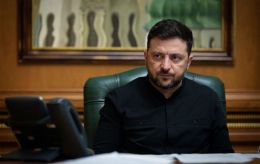ISW analyzes the pace of Ukrainian counteroffensive
 Ukrainian Armed Forces (Photo: Vitalii Nosach/RBC-Ukraine)
Ukrainian Armed Forces (Photo: Vitalii Nosach/RBC-Ukraine)
According to a report by the Institute for the Study of War, the Ukrainian military deliberately maintains a slower pace of advancement during their counteroffensive to preserve the combat effectiveness of the defense forces and exhaust the manpower and equipment reserves of the Russian occupiers.
Counteroffensive operations
On July 9, the Ukrainian Armed Forces conducted counteroffensive operations on at least three fronts.
Lieutenant General Oleksandr Syrskii stated that Ukrainian troops are successfully continuing their advance in the Bakhmut direction. Ukrainian officials also reported that the Ukrainian forces are conducting counteroffensive operations in the Berdiansk and Melitopol directions.
The Russian Ministry of Defense and Kremlin-affiliated bloggers claimed that Ukrainian defense forces launched attacks in the western part of the Zaporizhzhia region. A Russian "war correspondent" alleged that the Ukrainian Armed Forces were attacking Russian positions with small groups, targeting rear positions, depots, and infrastructure.
Ukrainian military officials also confirmed that the Armed Forces continue the campaigns to encircle the enemy in the southern and eastern parts of the country.
Advancement pace
The Wall Street Journal reported that Ukrainian forces are attempting to weaken the Russian defense prior to liberating the territory by agreeing to a slower pace of advance. It was also noted that the Ukrainian Armed Forces are focused on displacing Russian troops from fortifications and minefields, some of which extend more than 24 kilometers into the occupied territory.
Lieutenant Colonel Oleksii Telekhin from the 108th Territorial Defense Brigade informed WSJ that Russian occupiers can continuously introduce reinforcements, even if the Ukrainian military eliminates specific units.
According to ISW analysts, the Russian forces lack operational reserves. The statement by Telekhin, as believed by the Institute for the Study of War, likely pertains to local tactical reserves.
Another commander from the 108th Territorial Defense Brigade told journalists that the lack of armored vehicles complicates the Ukrainian troops' progress toward well-prepared positions. WSJ sources also highlighted the absence of air superiority as one of the factors slowing down the counteroffensive.
ISW experts believe that the current pace of the counteroffensive reflects deliberate efforts to preserve the combat effectiveness of the defense forces and "attrit Russian manpower and equipment at the cost of slower territorial advances.”
Key takeaways:
- US President Joe Biden stated that Ukraine cannot join NATO until Russia’s war in Ukraine is over.
- Russian Foreign Minister Sergei Lavrov discussed Turkey’s decision to allow the release of five Ukrainian commanders involved in the defense of the Azovstal Metallurgical Combine in Mariupol, Donetsk region with his Turkish counterpart Hakan Fidan on July 9.
- The Russian ultranationalist community continued to blame the Kremlin for trusting Turkey to uphold the deal and to keep Azovstal defenders in Turkey.
- Former Russian officer and ardent nationalist Igor Girkin claimed that the Russian Federal Security Service’s (FSB) Service for the Protection of the Constitutional Order is deliberately censoring him.
- Central African Republic Presidental Spokesperson Albert Yaloke Mokpem stated on July 8 that Wagner Group personnel leaving CAR are conducting rotations and are not withdrawing.
- Unknown persons leaked an image of what appears to be the Wagner Group’s founding charter on July 9, possibly to present the Wagner Group as a professional organization.
- Russian President Vladimir Putin’s decision to not rapidly dispose of the Wagner Group and prosecute rebellion participants is placing himself and his subordinates in an awkward position.
- Russian forces conducted limited ground attacks north of Svatove and south of Kreminna.
- Ukrainian and Russian forces continued counteroffensive operations in the Bakhmut area.
- Russian and Ukrainian forces continued ground attacks on the Avdiivka-Donetsk City line, and Russian forces advanced as of July 9.
- Ukrainian forces continued to advance in the Donetsk-Zaporizhzhia oblasts administrative border area and continued counteroffensive operations in the western Zaporizhzhia region.
- Russian forces reportedly continued to reestablish previously flooded positions on the east (left) bank of the Dnipro River in Kherson Oblast.
- Russian sources accused Ukrainian forces of targeting the Kerch Strait Bridge.
- The Russian Ministry of Defense is reportedly accepting Wagner Group mercenaries for contract service with the Russian MoD in Molkino, Krasnodar Krai.
Ukrainian counteroffensive
Since the beginning of June, the Ukrainian Armed Forces have been actively engaged in operations on multiple fronts. During this time, Ukrainian troops have managed to liberate nine populated areas in the southeastern part of the country from Russian occupiers.
Ukrainian soldiers are also making progress in the Bakhmut direction, successfully advancing south of the city to trap the enemy in a "kill zone."
Recently, Deputy Minister of Defense Hanna Maliar announced that the Ukrainian military had advanced more than a kilometer in the Bakhmut area. As a result, the enemy forces inside the city found themselves effectively trapped.

